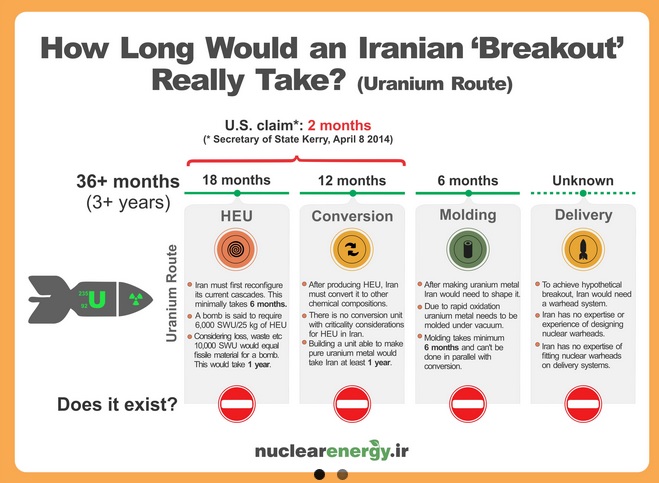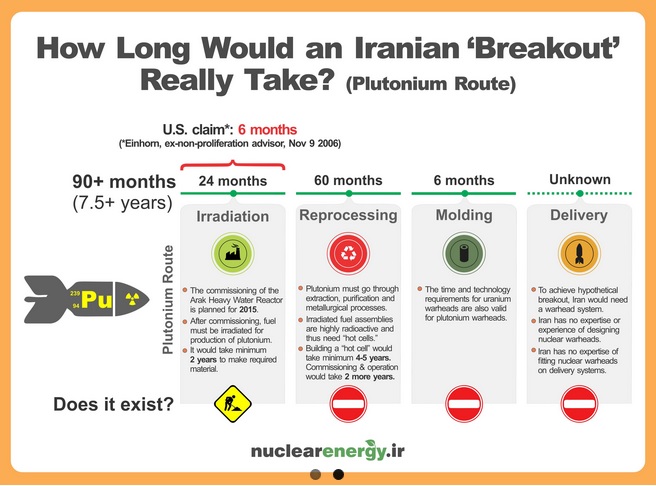In a new report, a quasi-official Iranian website has published its own timeline of how long it would take to produce enough enriched uranium for one bomb -- the so-called breakout time. It claims Tehran would need at least 18 months to produce enough enriched uranium for one bomb. But that timeline differs drastically from the U.S. estimate. Secretary of State John Kerry has claimed that Iran only needs two months to produce enough enriched uranium for a weapon.
The report comes as Iran is holding bilateral meetings with the world's six major powers before another round of nuclear talks. Iranian Foreign Minister Mohammad Javad Zarif tweeted a link to it on June 11.
The report claims Iran would need more than seven years to produce one bomb’s worth of plutonium.The United States, however, has estimated that Tehran would only need 6 months to produce enough plutonium for a bomb. The following is an excerpt from the press release with a link to the full text.
How Long Would an Iranian ‘Breakout’ Really Take?
In the report, the authors posit that with its current uranium enrichment capabilities, estimated at between 6860 and 10800 Separative Work Units (SWU), it would take Iran optimistically a minimum of 36 months and pessimistically more than 42 months to ‘break out’.
The authors argue that it would take between 12 to 18 months to complete the first step of the uranium route, which is to produce enough high enriched uranium (HEU) for a single bomb. However, they underscore that “the prerequisite of the processes outlined as involved in high enriched uranium (HEU) production is a reconfiguration of cascade piping and other auxiliary equipment.” This, they say, would take a minimum of 6 months. The report states that as the IAEA is present in Iran, conducting announced and unannounced inspections, and has daily access to Iran’s enrichment facilities, “it can provide early warning to the international community at the very beginning of the reconfiguration of cascades.”
Thus, the mere production of enough fissile material for a single bomb is estimated at 18-24 months, in sharp contrast to US Secretary of State John Kerry’s assertion in April that this process would take 2 months.
The report, “How long would an Iranian ‘breakout’ really take?”, further argues that the subsequent step towards a bomb, which is the construction of a unit able to produce pure uranium metal, would take at least an additional 12 months. Following the latter, the authors argue that the metal would then have to be shaped, a process which “itself takes an additional 6 months and cannot be carried out in parallel with the conversion.” They thus argue that steps 2 and 3 would take a combined 18 months, at least half of which must be carried out after the production of enough fissile material for a bomb.
The report does not account for the time needed to design a warhead system, stating that “Iran has no experience in this field, and thus has no experience of the complicated relevant mechanisms and technology.”
The report also provides a scientific review of the steps involved should Iran hypothetically adopt the plutonium route towards a bomb. The time needed to hypothetically develop a plutonium bomb is estimated at a minimum of 90 months, or 7.5 years.
The authors point out that there is no significant amount of plutonium in Iran, and tie proliferation allegations to the commissioning of the Arak Heavy Water (IR-40) reactor, which is planned for 2015. They point out that “even after commissioning, the reactor must work for at least two years to produce the required fissile material.”
The authors further posit that plutonium would then need to be extracted from the irradiated fuel and purified to nuclear weapon grade. They underscore that Iran has no “hot cell”, which is needed for plutonium extraction and further processes. The time required for construction of such a facility is estimated at a minimum of 4 to 5 years, while the commissioning and operation would require another 1 to 2 years. The report states that “Iran has repeatedly said that it has no plan to engage in such activities.” Indeed, any Iranian attempt to engage in such activity will be detected by the IAEA, which is engaged in robust inspections in Arak.
The authors further argue that the material “would then need to go through metallurgical processes, as with uranium metal, but with major differences”, estimating that this step would take a minimum of 6 months. Lastly, the report argues that the time and technology requirements for development of a uranium warhead are also valid for a plutonium device, and “will add to the hypothetical time of breakout with plutonium.”


